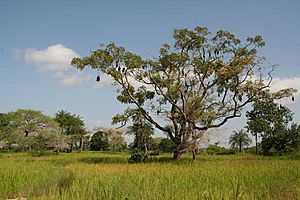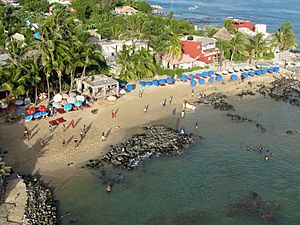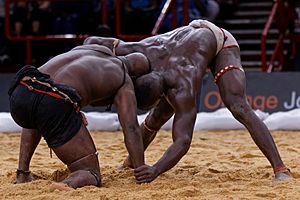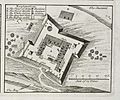Senegal facts for kids
Quick facts for kids
Republic of Senegal
|
|
|---|---|
|
|
|
|
Motto: "Benn askan, Benn mébet, Benn ngëm" (Wolof)
"One People, One Goal, One Faith" |
|
|
Anthem:
"Gaynde gu xonq gi" "The Red Lion" |
|

Location of Senegal (dark green)
|
|
| Capital and largest city
|
Dakar 14°40′N 17°25′W / 14.667°N 17.417°W |
| Official languages | French Wolof Pulaar |
| National languages |
|
| Lingua franca | |
| Ethnic groups
(2019)
|
|
| Religion
(2019)
|
|
| Demonym(s) | Senegalese |
| Government | Unitary presidential republic |
| Bassirou Diomaye Faye | |
| Ousmane Sonko | |
|
• President of the National Assembly
|
Amadou Mame Diop |
| Legislature | National Assembly |
| Independence | |
|
• Republic established
|
25 November 1958 |
|
• Independence from France
|
20 June 1960 |
|
• Withdrawal from
the Mali Federation |
20 August 1960 |
|
• Dissolution of the Senegambia Confederation
|
30 September 1989 |
| Area | |
|
• Total
|
196,722 km2 (75,955 sq mi) (86th) |
|
• Water (%)
|
2.1 |
| Population | |
|
• 2024 estimate
|
18,847,519 (68th) |
| GDP (PPP) | 2023 estimate |
|
• Total
|
|
|
• Per capita
|
|
| GDP (nominal) | 2023 estimate |
|
• Total
|
|
|
• Per capita
|
|
| Gini (2011) | 40.3 medium |
| HDI (2022) | low · 169th |
| Currency | West African CFA franc (XOF) |
| Time zone | UTC (GMT) |
| Date format | dd/mm/yyyy |
| Driving side | right |
| Calling code | +221 |
| ISO 3166 code | SN |
| Internet TLD | .sn |
Senegal, officially the Republic of Senegal, is the westernmost country in continental Africa, situated on the Atlantic Ocean coastline. Senegal is bordered by Mauritania to the north, Mali to the east, Guinea to the southeast and Guinea-Bissau to the southwest. Senegal nearly surrounds The Gambia, a country occupying a narrow sliver of land along the banks of the Gambia River, which separates Senegal's southern region of Casamance from the rest of the country. Senegal also shares a maritime border with Cape Verde. Senegal's economic and political capital is Dakar.
Contents
History
In the 15th century, Portuguese people came to Gorée Island off the coast of Dakar. In the 17th century, French people and Dutch people came there, too. These European countries used the island as a trading post in slaves from the mainland, controlled by the Muslim Wolof Empires. Slavery was later made illegal by France, but soon after, around 1850, the French started to conquer the Wolof. By 1902 Senegal was a part of the French colony French West Africa.
In January 1959, Senegal and the French Sudan became one to form the Mali Federation, which became fully independent on June 20, 1960, as a result of the independence and transfer of power agreement signed with France on April 4, 1960. This did not last long and Senegal and Mali broke apart into separate nations. Between 1982 and 1989 Senegal and The Gambia joined together to make Senegambia.
Geography
Senegal is located on the west of the African continent. It lies between latitudes 12° and 17°N, and longitudes 11° and 18°W.
Senegal is externally bounded by the Atlantic Ocean to the west, Mauritania to the north, Mali to the east, and Guinea and Guinea-Bissau to the south; internally it almost completely surrounds The Gambia, namely on the north, east and south, except for Gambia's short Atlantic coastline.
The Senegalese landscape consists mainly of the rolling sandy plains of the western Sahel which rise to foothills in the southeast. Here is also found Senegal's highest point, an otherwise unnamed feature 2.7 km southeast of Nepen Diakha at 648 m (2,126 ft). The northern border is formed by the Senegal River; other rivers include the Gambia and Casamance Rivers. The capital Dakar lies on the Cap-Vert peninsula, the westernmost point of continental Africa.
The Cape Verde islands lie some 560 kilometres (350 mi) off the Senegalese coast, but Cap-Vert ("Cape Green") is a maritime placemark, set at the foot of "Les Mammelles", a 105-metre (344 ft) cliff resting at one end of the Cap-Vert peninsula onto which is settled Senegal's capital Dakar, and 1 kilometre (0.6 mi) south of the "Pointe des Almadies", the westernmost point in Africa.
Climate
Senegal has a tropical climate with pleasant heat throughout the year with well-defined dry and humid seasons that result from northeast winter winds and southwest summer winds. The dry season (December to April) is dominated by hot, dry, harmattan wind. Dakar's annual rainfall of about 600 mm (24 in) occurs between June and October when maximum temperatures average 30 °C (86.0 °F) and minimums 24.2 °C (75.6 °F); December to February maximum temperatures average 25.7 °C (78.3 °F) and minimums 18 °C (64.4 °F).
Government and politics
Senegal is a republic with a presidency; the president is elected every five years as of 2016, previously being seven years from independence to 2001, five years from 2001 to 2008, and seven years again from 2008 to 2016, by adult voters.
Senegal has more than 80 political parties. The unicameral parliament consists of the National Assembly, which has 150 seats (a Senate was in place from 1999 to 2001 and 2007 to 2012). An independent judiciary also exists in Senegal. The nation's highest courts that deal with business issues are the constitutional council and the court of justice, members of which are named by the president.
Economy
The main industries include food processing, mining, cement, artificial fertilizer, chemicals, textiles, refining imported petroleum, and tourism. Exports include fish, chemicals, cotton, fabrics, groundnuts, and calcium phosphate. The principal foreign market is India with 26.7% of exports (as of 1998). Other foreign markets include the United States, Italy and the United Kingdom.
Languages
French is the official language, spoken by all those who have spent several years in the educational system, in which French is used as the medium of instruction. Overall, speakers of French were estimated to make up 26% of the population in 2022.
Most people also speak their own ethnic language while, especially in Dakar, Wolof is the lingua franca. Pulaar is spoken by the Fulas and Toucouleur. The Serer language is widely spoken by both Serers and non-Serers (including President Sall, whose wife is Serer); so are the Cangin languages, whose speakers are ethnically Serers. Jola languages are widely spoken in the Casamance. Overall Senegal is home to around 39 distinct languages. Several have the legal status of "national languages": Balanta-Ganja, Arabic, Jola-Fonyi, Mandinka, Mandjak, Mankanya, Noon (Serer-Noon), Pulaar, Serer, Soninke, and Wolof.
English is taught as a foreign language in secondary schools and many graduate school programs, and it is the only subject matter that has a special office in the Ministry of Education.
Regions
- Dakar
- Diourbel
- Fatick
- Kaffrine
- Kaolack
- Kédougou
- Kolda
- Louga
- Matam
- Saint-Louis
- Sédhiou
- Tambacounda
- Thiès
- Ziguinchor
Largest cities
Dakar, the capital, is by far the largest city in Senegal, with over two million residents. The second most populous city is Touba, a de jure communaute rurale (rural community), with over half a million people.
|
Largest cities or towns in Senegal
According to the 2013 Census |
||
|---|---|---|
| Rank | Name | Pop. |
| 1 | Dakar | 2,646,503 |
| 2 | Touba | 753,315 |
| 3 | Pikine | 317,763 |
| 4 | Kaolack | 233,708 |
| 5 | M'bour | 232,777 |
| 6 | Rufisque | 221,066 |
| 7 | Ziguinchor | 205,294 |
| 8 | Diourbel | 133,705 |
| 9 | Tambacounda | 107,293 |
| 10 | Louga | 104,349 |
Culture
Senegal is well known for the West African tradition of storytelling, which is done by griots, who have kept West African history alive for thousands of years through words and music. The griot profession is passed down generation to generation and requires years of training and apprenticeship in genealogy, history and music. Griots give voice to generations of West African society.
The African Renaissance Monument built in 2010 in Dakar is the tallest statue in Africa. Dakar also hosts a film festival, Recidak.
The Islamic festival of Eid al-Fitr, known locally as Tabaski, is popularly celebrated by Senegalese people. Despite being predominantly Muslim, the Christian festival of Christmas is also popularly observed, with Christmas trees and decorations lining up the city of Dakar.
Cuisine
Because Senegal borders the Atlantic Ocean, fish is very important. Chicken, lamb, peas, eggs, and beef are also used in Senegalese cooking, but not pork, due to the nation's largely Muslim population. Peanuts, the primary crop of Senegal, as well as couscous, white rice, sweet potatoes, lentils, black-eyed peas and various vegetables, are also incorporated into many recipes. Meats and vegetables are typically stewed or marinated in herbs and spices, and then poured over rice or couscous, or eaten with bread.
Popular fresh juices are made from bissap, ginger, buoy (pronounced 'buoy', which is the fruit of the baobab tree, also known as "monkey bread fruit"), mango, or other fruit or wild trees (most famously soursop, which is called corossol in French). Desserts are very rich and sweet, combining native ingredients with the extravagance and style characteristic of the French impact on Senegal's culinary methods. They are often served with fresh fruit and are traditionally followed by coffee or tea.
Music
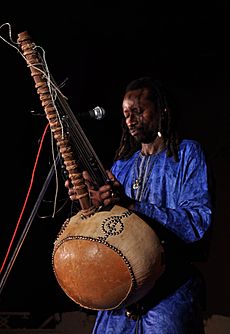
Senegal is known across Africa for its musical roots, due to the popularity of mbalax, which originated from the Serer percussive tradition especially the Njuup, it has been popularized by Youssou N'Dour, Omar Pene and others. Sabar drumming is especially popular. The sabar is mostly used in special celebrations such as weddings. Another instrument, the tama, is used in more ethnic groups. Other popular international renowned Senegalese musicians are Ismael Lô, Cheikh Lô, Orchestra Baobab, Baaba Maal, Akon (US-born), Thione Seck, Viviane, Fallou Dieng, Titi, Seckou Keita and Pape Diouf.
Sport

Senegalese play many sports. Wrestling and football are the most popular sports in the country. Senegal will host the 2026 Summer Youth Olympics in Dakar, making Senegal the first African country to host an Olympic event.
Senegalese wrestling is the country's most popular sport and has become a national obsession. It traditionally serves many young men to escape poverty and it is the only sport recognized as developed independently of Western culture.
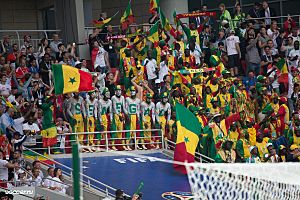
Football is a popular sport in Senegal. In 2022 the national team beat Egypt to win the Africa Cup of Nations for the first time, and they were runners-up in 2002 and 2019. They became one of only five African teams to ever reach the quarter-finals of the FIFA World Cup, after Cameroon in 1990 and before Ghana in 2010, defeating holders France in their first game in 2002. Senegal qualified for the 2018 FIFA World Cup in Russia, and for the 2022 FIFA World Cup in Qatar.
Senegal has traditionally been one of Africa's dominant basketball powers. The men's team performed better than that of any other African nation at the 2014 FIBA World Cup, where they reached the playoffs for the first time. The women's team won 19 medals at 20 African Championships, more than twice as many medals as any competitor. When the country hosted the 2019 FIBA Women's AfroBasket, 15,000 fans flocked to the Dakar Arena which is registered as a record attendance for basketball in Africa. Senegal was one of the continent's pioneers in basketball as it established one of Africa's first competitive leagues.
In 2016, the NBA announced the launch of an Elite's Academy in Africa, and more precisely in Senegal.
The country hosted the Paris–Dakar rally from 1979 until 2007. The Dakar Rally was an off-road endurance motorsport race which followed a course from Paris, France, to Dakar, Senegal. The competitors used off-road vehicles to cross the difficult geography. The last race was held in 2007, before the 2008 rally was canceled a day before the event due to security concerns in Mauritania. The Ocean X-Prix of the electric off-road championship Extreme E was also hosted in Senegal.
Images for kids
-
The Portuguese Empire was the first European power to colonize Senegal, beginning with the arrival of Dinis Dias in 1444 at Gorée Island and ending in 1888, when the Portuguese gave Ziguinchor to the French.
-
Our Lady of Victories Cathedral, a catholic church in Dakar
See also
 In Spanish: Senegal para niños
In Spanish: Senegal para niños




